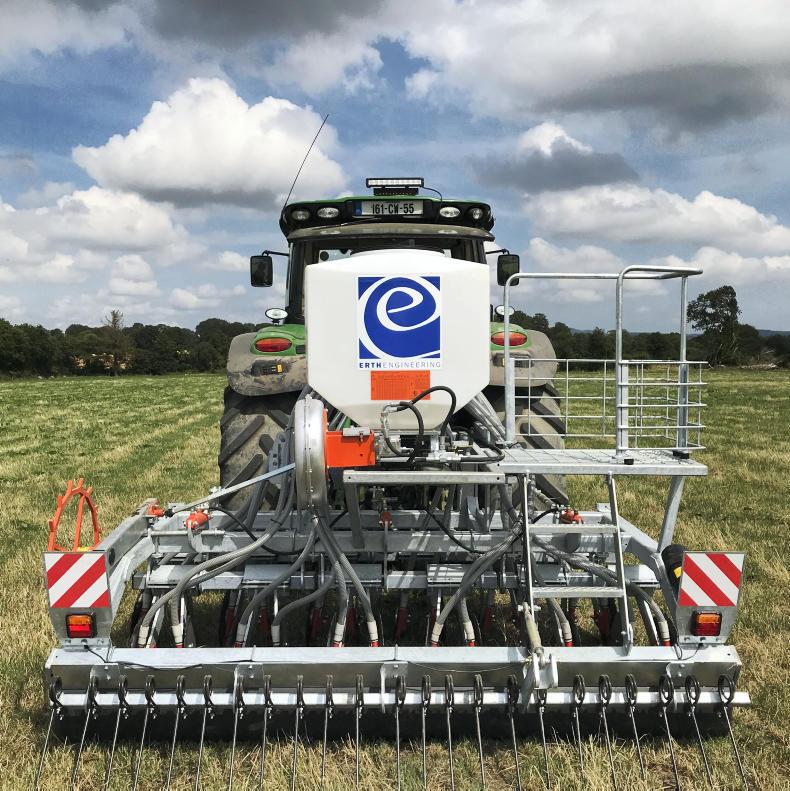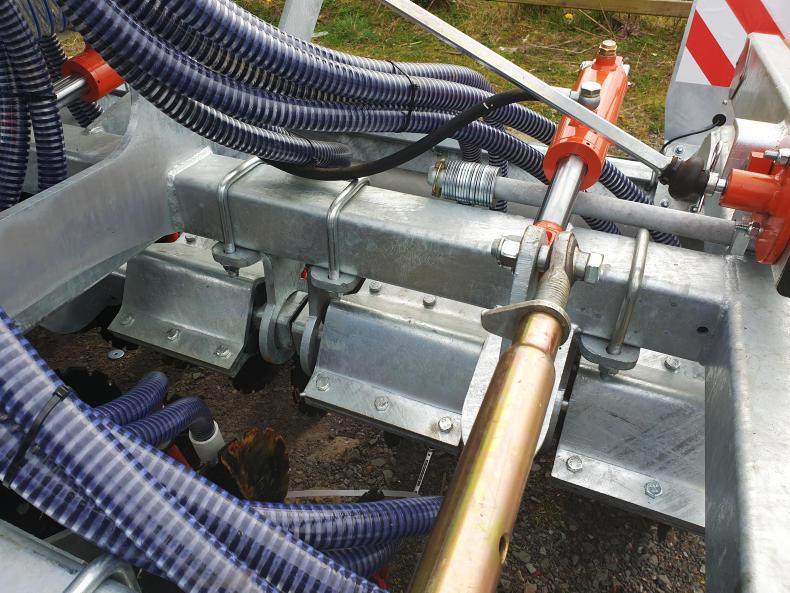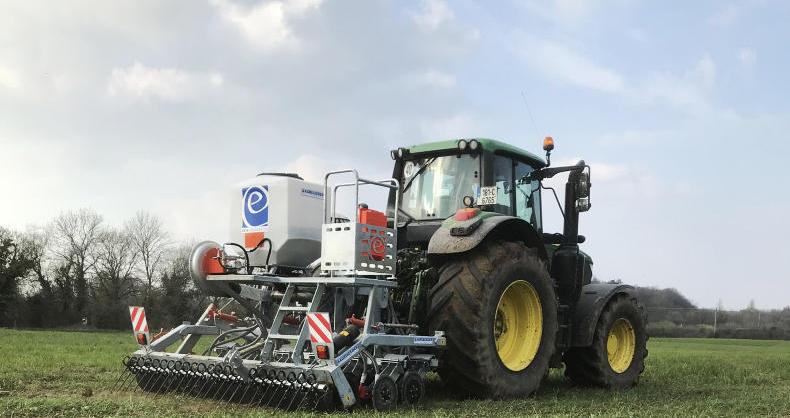Overlooking the Atlantic ocean in Killala, Co Mayo, brothers Alastair and Alan McCormick are milking 280 cows. The farm was host to a tillage enterprise, specialising in growing seed potatoes up until 2004. It was then put into grass and became home for the brothers’ large herd of cows. With an ever increasing emphasis on growing and utilising more grass, the duo felt they could get more from some of their land and made the decision to purchase an Erth Agriseeder direct drill.
Previously running a power harrow with a mounted grass box, Alastair says that they felt this method was taking too long for the paddocks to be returned to the rotation.

It’s equipped with a 300-litre hopper which Alastair notes holds 10 bags of grass seed.
They contacted Erth Engineering about organising a demonstration unit. Having successfully bought a panbuster from the Northern Irish firm the previous year, the McCormicks were fans of the company’s equipment and liked the concept of the Agriseeder.
The brothers took in a demo unit in the summer of 2018 and again in the spring of 2019. Having tried out the concept in a number of different situations, the brothers made the decision to purchase the drill in June last year.
“With the power harrow and grass box, we found that it took six to eight weeks for the roots of the new seedlings to grip. However, with the Erth direct drilling concept, the pluck test showed we could graze after three to four weeks of stitching in. It allowed us to get cows into paddocks by about two weeks earlier which was a big boost. The Agriseeder also allowed us to get new grass growing in paddocks with stones that weren’t suitable for even the power harrow, increasing grass production,” Alastair says.
The machine
The McCormicks’ machine is a 24-row 3m drill. This offers row spacings of 125mm and a row width of 7mm. It is equipped with a 300-litre hopper which Alastair notes holds 10 bags of grass seed.
The Agriseeder has three separate 1m-wide frame sections. Each section applies its own independent surface pressures. The three sections are pressurised individually through its own hydraulic ram which is linked to an overall hydraulic pressure system. Alastair believes the drill is good to follow the contours of the ground.
The mushroom distribution head is transparent, meaning the operator can see that there is still seed in the distribution tubes. This seed distribution unit is located between the tractor and the hopper. Alastair says that once the seed runs out, there is a notable change in noise. This means that a separate low level sensor is not required. Erth Engineering sources the metering unit from Kverneland.
The drill is fitted with serrated discs, which Erth Engineering sources from Forge De Niaux. These discs cut a narrow slit 10mm to 15mm into the surface. The seed is then placed in the ground via the coulters. These coulters come with replaceable tungsten carbide tips and are loaded against the discs by rubber washers.
Alastair says: “I’ve around 110 acres drilled so far and I can’t see any wear on the discs. I’ve a friend in Canada running the same discs and he’s covered 5,000 acres and still on the original discs, so I’m hoping to get a lot of acres out of them.”
Once the seed is placed in the ground, it is followed by a smooth roller. The roller also serves as a depth control unit. As the drill is ground-drive, the forward speed and the seed metering system are controlled by a wheel attached to the roller unit.
“We operate the drill on a Case Maxxum 125. It’s well able to handle the 1,500kg drill. I use a T-jet Matrix 430 basic GPS system to measure the acreage covered. Depending on the ground, we sow at a speed in the region of 6km/h to 12km/h. Sometimes it can be hard to see what you’ve sowed or not. In typical west of Ireland conditions, we sow around three acres an hour. The drill is built to last – you could nearly say it’s over-engineered. It is rock solid, yet delicate on seed,” Alastair says.
The McCormicks purchased their first direct drill in 1986, so they are no strangers to the concept.
Alastair says that once the soil pH and fertility are right, direct seeding can be more cost-effective and offer a quicker return than the conventional method of ploughing and tilling.
“We found that the preparation method for the land used when direct drilling with the Agriseeder varies from field to field, but will be vital for a successful germination. We have sowed grass into grass and also burnt off the existing sward three days after drilling. It’s field-specific.
“For good germination, a programme such as not applying slurry or fertiliser for a week or two post sowing is sometimes required. In fairness to Erth Engineering, they provide super backup support but, more importantly, good advice on the best method available to suit the varying conditions,” Alastair explains.

Each section applies its own independent surface pressures through its own hydraulic ram which is linked to an overall hydraulic pressure system.
Since taking delivery of the drill last August, the McCormicks have done 110 acres, 70 acres for themselves with the remainder for neighbours.
“Last autumn, we picked out some of our underperforming fields with hybrid varieties and hit them with high-performing ryegrass varieties. We are delighted with how they’ve performed this spring. We have noted an increase in cow performance and better graze-outs. The advantage of not having to pick stones when reseeding was another major benefit,” Alastair says.
Prices for the 3m Agriseeder start from €24,600 plus VAT.
Working width: 3m.Number of rows: 24.Row spacings: 125mm.Row width: 7mm.Hopper capacity: 300 litres.Weight: 1,500kg.Price: starting from €24,600 plus VAT.
Overlooking the Atlantic ocean in Killala, Co Mayo, brothers Alastair and Alan McCormick are milking 280 cows. The farm was host to a tillage enterprise, specialising in growing seed potatoes up until 2004. It was then put into grass and became home for the brothers’ large herd of cows. With an ever increasing emphasis on growing and utilising more grass, the duo felt they could get more from some of their land and made the decision to purchase an Erth Agriseeder direct drill.
Previously running a power harrow with a mounted grass box, Alastair says that they felt this method was taking too long for the paddocks to be returned to the rotation.

It’s equipped with a 300-litre hopper which Alastair notes holds 10 bags of grass seed.
They contacted Erth Engineering about organising a demonstration unit. Having successfully bought a panbuster from the Northern Irish firm the previous year, the McCormicks were fans of the company’s equipment and liked the concept of the Agriseeder.
The brothers took in a demo unit in the summer of 2018 and again in the spring of 2019. Having tried out the concept in a number of different situations, the brothers made the decision to purchase the drill in June last year.
“With the power harrow and grass box, we found that it took six to eight weeks for the roots of the new seedlings to grip. However, with the Erth direct drilling concept, the pluck test showed we could graze after three to four weeks of stitching in. It allowed us to get cows into paddocks by about two weeks earlier which was a big boost. The Agriseeder also allowed us to get new grass growing in paddocks with stones that weren’t suitable for even the power harrow, increasing grass production,” Alastair says.
The machine
The McCormicks’ machine is a 24-row 3m drill. This offers row spacings of 125mm and a row width of 7mm. It is equipped with a 300-litre hopper which Alastair notes holds 10 bags of grass seed.
The Agriseeder has three separate 1m-wide frame sections. Each section applies its own independent surface pressures. The three sections are pressurised individually through its own hydraulic ram which is linked to an overall hydraulic pressure system. Alastair believes the drill is good to follow the contours of the ground.
The mushroom distribution head is transparent, meaning the operator can see that there is still seed in the distribution tubes. This seed distribution unit is located between the tractor and the hopper. Alastair says that once the seed runs out, there is a notable change in noise. This means that a separate low level sensor is not required. Erth Engineering sources the metering unit from Kverneland.
The drill is fitted with serrated discs, which Erth Engineering sources from Forge De Niaux. These discs cut a narrow slit 10mm to 15mm into the surface. The seed is then placed in the ground via the coulters. These coulters come with replaceable tungsten carbide tips and are loaded against the discs by rubber washers.
Alastair says: “I’ve around 110 acres drilled so far and I can’t see any wear on the discs. I’ve a friend in Canada running the same discs and he’s covered 5,000 acres and still on the original discs, so I’m hoping to get a lot of acres out of them.”
Once the seed is placed in the ground, it is followed by a smooth roller. The roller also serves as a depth control unit. As the drill is ground-drive, the forward speed and the seed metering system are controlled by a wheel attached to the roller unit.
“We operate the drill on a Case Maxxum 125. It’s well able to handle the 1,500kg drill. I use a T-jet Matrix 430 basic GPS system to measure the acreage covered. Depending on the ground, we sow at a speed in the region of 6km/h to 12km/h. Sometimes it can be hard to see what you’ve sowed or not. In typical west of Ireland conditions, we sow around three acres an hour. The drill is built to last – you could nearly say it’s over-engineered. It is rock solid, yet delicate on seed,” Alastair says.
The McCormicks purchased their first direct drill in 1986, so they are no strangers to the concept.
Alastair says that once the soil pH and fertility are right, direct seeding can be more cost-effective and offer a quicker return than the conventional method of ploughing and tilling.
“We found that the preparation method for the land used when direct drilling with the Agriseeder varies from field to field, but will be vital for a successful germination. We have sowed grass into grass and also burnt off the existing sward three days after drilling. It’s field-specific.
“For good germination, a programme such as not applying slurry or fertiliser for a week or two post sowing is sometimes required. In fairness to Erth Engineering, they provide super backup support but, more importantly, good advice on the best method available to suit the varying conditions,” Alastair explains.

Each section applies its own independent surface pressures through its own hydraulic ram which is linked to an overall hydraulic pressure system.
Since taking delivery of the drill last August, the McCormicks have done 110 acres, 70 acres for themselves with the remainder for neighbours.
“Last autumn, we picked out some of our underperforming fields with hybrid varieties and hit them with high-performing ryegrass varieties. We are delighted with how they’ve performed this spring. We have noted an increase in cow performance and better graze-outs. The advantage of not having to pick stones when reseeding was another major benefit,” Alastair says.
Prices for the 3m Agriseeder start from €24,600 plus VAT.
Working width: 3m.Number of rows: 24.Row spacings: 125mm.Row width: 7mm.Hopper capacity: 300 litres.Weight: 1,500kg.Price: starting from €24,600 plus VAT. 







 This is a subscriber-only article
This is a subscriber-only article










SHARING OPTIONS: